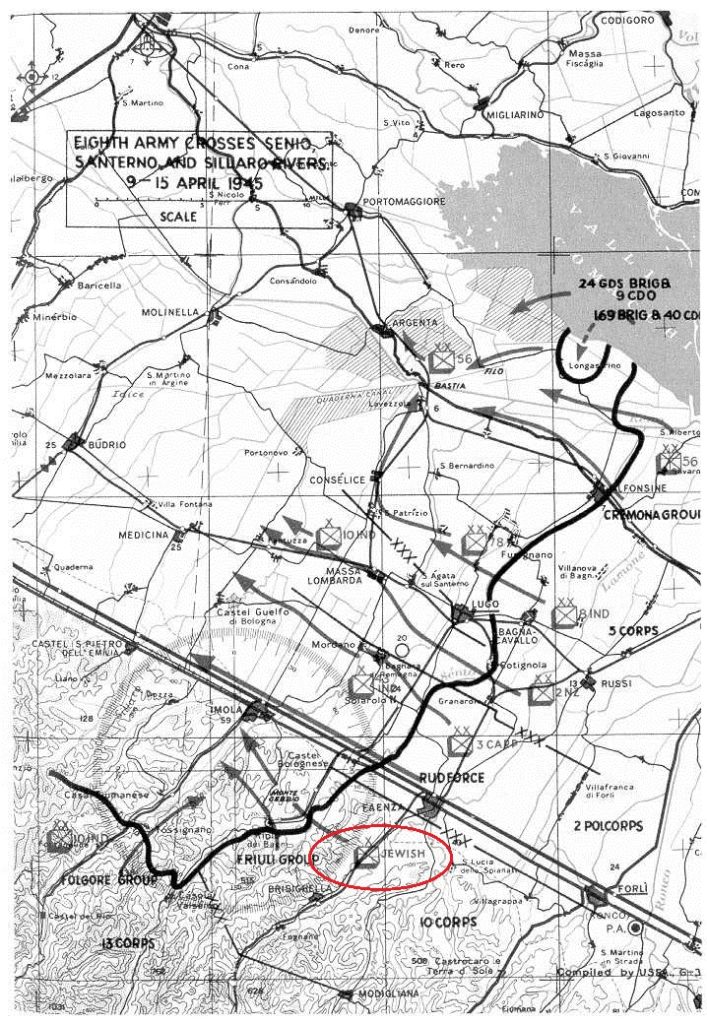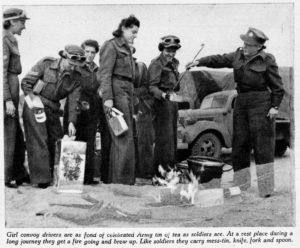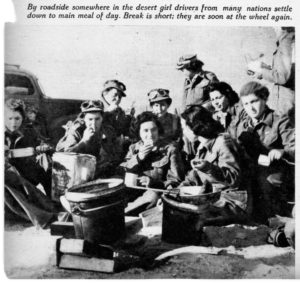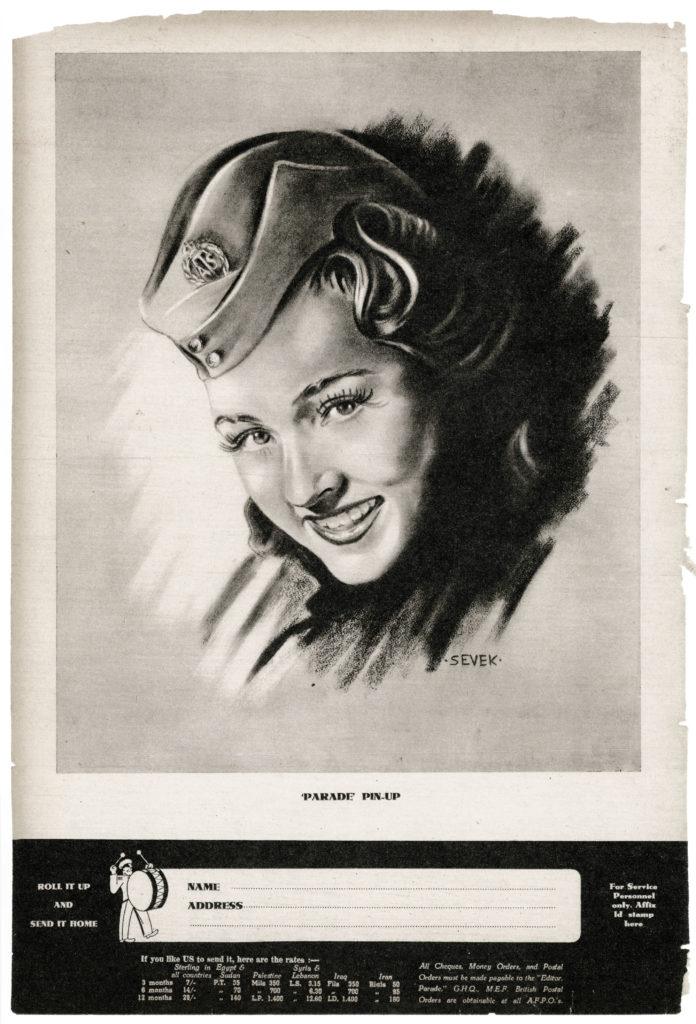One purpose of this blog has been to present information about the military service of Jews, across a variety of eras, conflicts, and locations, with – well, at least so far, and for the immediate future – an emphasis on Jewish military service during the First and Second World Wars. Accordingly, most of the information and photographs thus far presented have focused upon the military service of Jews in the armed forces of the WW II Allies, and for WW I, both the Allies and Germany.
In terms of the Second World War, the post covering women drivers in Britain’s Auxiliary Territorial Service (the A.T.S.) was derived from and based upon a group of photographs published in Parade – Middle-East Weekly, on February 12, 1944.
But, Parade has far more to offer: One such item is a photo essay that was published in Parade’s issue of April 14, 1945, focusing on Pesach (Passover) services held by soldiers of the Jewish Brigade of the Second World War in late March of 1945.
____________________
Certainly well known in the Jewish press of the Second World War (both within and certainly beyond the English-speaking world) the singular significance of the Jewish Brigade was that – as a military formation, though small in terms of numbers – it manifested and symbolized a necessary and critical step on the path towards Jewish military and ultimately political autonomy, regardless of how tentative such autonomy actually was prior to May of 1948. For in the lives of nations as much as individuals, symbols (that’s why countries have flags) and symbolic actions can be as important as reality, for they can inspire; if not generate; if not perpetuate that reality. And, in a practical sense, postwar, members of the Brigade provided aid – physical, psychological, and spiritual – to survivors of the Shoah.
In terms of the unit’s actual designation, while popularly known as the “Jewish Brigade”, the unit was actually the “Jewish Infantry Brigade Group”, and was a component of the Palestine Regiment.
The Palestine Regiment itself had been formed in August of 1942, and was comprised of separate infantry companies (“Palestine Infantry Companies”) first formed in 1940 from among Arabs and Jews living in Mandatory Palestine, these companies – at that time – having been part of the Royal East Kent Regiment, otherwise known as “The Buffs”.
The Palestine Regiment was reformed in 1944, with the Brigade’s creation being announced on 20 September. The Brigade was comprised of three infantry Battalions (1st, 2nd, and 3rd), and the 200th Field Regiment, the latter a component of the Royal Artillery.
There are a number of interesting and valuable sources of information about the Jewish brigade, ranging from the scholarly to the more “popular”, differing in literary tone, style, and emphasis. Several such works are in English, while I suppose (?!) there are vastly more in Hebrew and Yiddish.
According to Appendix I of Morris Beckman’s The Jewish Brigade, the Jewish Brigade Group suffered the loss of 83 soldiers killed in action or died from wounds, and, 200 wounded. Beckman’s book does not delineate the criteria for the determination of these numbers, but, does mention that they’re based on information provided by the Commonwealth War Graves Commission, the Imperial War Museum, and, information in Jacob Lifshitz’s Sefer ha-Brigadah ha-Yehudit: Korot ha-ḥaṭivah ha-loḥemet ṿeha-matsilah et ha-Golah (Book of the Jewish Brigade / The Story of the Jewish Brigade Fighting and Rescuing the Diaspora) (ספר הבריגדה היהודית קורות החטיבה היהודית הלוחמת והמצילה את הגולה).
The Brigade’s awards are given as follows:
Military Cross – 4
Military Medal – 7
Member of the British Empire – 4
Commander of the British Empire – 1
Order of the British Empire – 2
United States awards – 2
Mentioned in Dispatches – 78
My research, based on the CWGC database, both volumes (1989 and 1994) of Henry Morris’ We Will Remember Them, and Yoav Gelber’s Jewish Palestinian Volunteering in the British Army During the Second World War), show the following losses:
Between April, 1941 and May, 1944: As members of the Palestine Regiment, before the establishment of the Jewish Infantry Brigade Group: 33 soldiers, killed in action and / or died on active service; one soldier (Pvt. Norbert Gabriel, PAL/11574) as a POW in Greece.
Between October 20, 1944, and May 7, 1945: After the actual formation of the Jewish Infantry Brigade Group, during combat in Italy: 40 soldiers.
From May 9, 1945 to November 20, 1946: Postwar, on active service: 19 soldiers.
Just as the date of the photographs is indicated in the article, so is the Brigade’s location: Near the Senio River, in northern Italy. This is described in greater clarity in Beckman’s book:
“On 23 March 1945 178 Company received new orders. They were to move up to the line at once, and again the long convoy, with their men eager for battle, took to the road. Eventually they reached their base at the small village of Brisighella. This was an idyllic spot, on a ridge from which they could look across orchards, olive groves and vineyards sloping down to the south bank of the Senio. Confronting their sector was the crack German 4th Paratroop Division. From their hilltop positions on the north side of the river, the Germans could observe the Brigade, especially during daylight hours, when their snipers and light artillery frequently reminded the more incautious Brigadiers that curiousity killed the cat.”
And with that, here’s Parade’s article…
FRONT LINE PASSOVER
Parade – Middle East Weekly
April 14, 1945
“Parade” reporter GEORGE BONNEY and cameraman BELA ZOLA visit the Jewish Brigade during Passover
The Jewish Brigade is in action. They were firmly established on the Eighth Army front while World Jewry celebrated Passover. That their battle inauguration coincided with the age-old custom was, for them, an historical occasion for the word Passover, properly interpreted, means “The Festival of Freedom.”
Up in the line, near the Senio river, the Chaplain said: “We are now in the front line of the fight for freedom. It is an opportunity to avenge our people.”
Circumstances would not allow the full ceremony, but the troops began their eight-day ritual in the best way possible. Alert in their positions they observed the Seder — opening feast—with Palestine wine and Matzot. The Matzot or unleavened bread is essential because it commemorates the exodus of Jews from Egypt when, unable to wait for their bread to rise, they quickly baked flat cakes and fled.
The military authorities were extremely considerate and helpful. Matzot was provided through normal Army channels and, with a special consignment of Palestine wine, was sent up the line by mule train under the cover of darkness. Possible, but he couldn’t be everywhere. Some detachments were obliged to read their own Haggadah, a narration of the Exodus.
We traveled up to a forward position to see the preparations.
Dug in on the banks of the Senio, a mortar detachment prepared their feast with augmented Army rations. They planned to celebrate in the evening but cooked by day, because their derelict strongpoint received enemy attention at night. As a matter of fact, shells lobbed over during the day and their location is fast becoming scarred with yawning holes. Still, they grinned and filled hay box containers to await the appropriate time for the Seder.
In the husk of a farmhouse, barely 1,000 yards from the enemy, we saw an infantry platoon enjoy an Eve of Passover lunch. They ate in relays while some of their number cleaned weapons and the wireless operator, mug in hand, sat listening – intent on his task. Supplies had not caught up with them but, somewhere, somehow, they had gathered tulips and spring bulbs. Perched on the crazily warped window ledge, the flowers added a touch of gaiety to the desolation around them.
The M.O. was later going to take the service. They had set up their position behind a crumbled church. A knocked-out Sherman, relic of a former battle, provided sleeping quarters. With the earth scooped out from underneath and the turret cleared it affords a two-storied residence.
Later we visited a troop of 25-pdr gunners. Arrangements had been made to hold a service between the gun positions, but the rain streamed down, lightning flashed and the crashing of thunder mingled with the gun-fire. Hurriedly everything was moved into the attic of a nearby farmhouse and those of the troop not on duty crowded in to join the festival.
Lighted candles cast eerie shadows on the ancient rafters, but the gathering sang their Palestinian folk-songs with cheerful abandon. True, it was all part of their annual festival, but there was something more to it – determination and tremendous enthusiasm to carry on the fight. Indeed, training was speeded up and the Jewish Brigade entered the line earlier than was originally intended.
Volunteers from British units have transferred and there are representatives from more than 30 nations in the Brigade. Many are orthodox in their religious beliefs and everything is done to respect the Kosher principles. A Shohet (slaughterer) travels with H.Q., and live cattle are dealt with in suitable circumstances. At other times an alternative ration scale is issued, containing among other things, canned fish.
______________________________
“The Jewish Brigade, composed mainly of Palestinians but containing a number of United Kingdom Jews transferred from other units, is in action in Italy. Passover, festival of freedom, is celebrated in front line; Jewish chaplain leads congregation in reading from Haggadah, narration of exodus from Egypt.”
(Though no names are presented among the photo captions with the exception of Brigadier Benjamin, there is a clue to the identity of the officer leading Erev Seder Services: The three pips on his epaulette designate the rank of Captain. Based on Morris Beckman’s The Jewish Brigade, he is either (? – !) Captain Shimon Mazo, or, Captain Leon Shalit, both of whom – as junior chaplains – conducted Seder Night Services, which had been organized by Senior Chaplain Rabbi Bernard M. Caspar.
The very fact that the photo essay has a date associated with it – Pesach of 1945 – enables the determination of the time – let alone the day! – when this image was captured: About 6:35 P.M., Wednesday, March 28, 1945. (The 14th of Nisan, in the year 5705.)
 ______________________________
______________________________
“Infantry platoon men off duty east Matzot, unleavened bread, drink Palestine wine, in much shelled farmhouse. Matzot was provided by a British D.I.D.”
(Coincidentally, one of the soldiers in the photo may be identifiable: A box or container of some sort, bent and folded, is prominently located in the right center of the table. Upon the end of this object is the surname “NADLER”. Is “Nadler” the soldier seated at the right center of the photo?)
(“D.I.D.”? – “Detail Issue Depot”)
 ______________________________
______________________________
“Platoon signaler remains at his post, keeps contact with troops ever further forward. Platoon have to eat Passover lunch in relays as men come off duty.”
 ______________________________
______________________________
“Monocled Brigadier E.F. Benjamin, commanding Jewish Brigade, a Canadian-born regular British Army officer, with some of staff.”
 ______________________________
______________________________
“Company commander on way to battle-scarred farmhouse on top of hill keeps carefully to track as land is mined. Heaps of earth on left are dug-outs.”
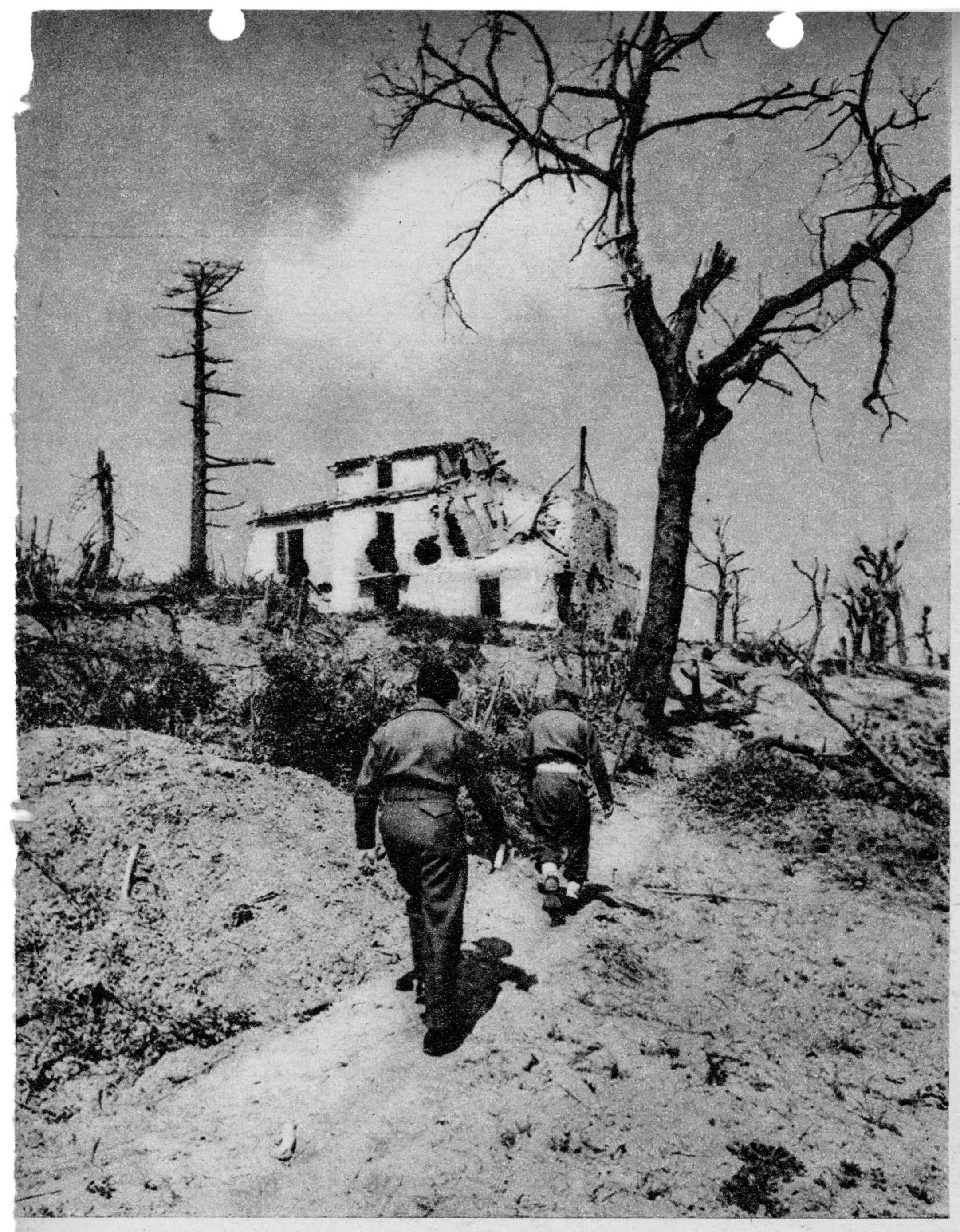 ______________________________
______________________________
“Cookhouse of mortar detachment is only 1,000 yards from German lines and cook must raise as little smoke as possible or he will attract more enemy shells.”
 ______________________________
______________________________
“Men of 25-pdr battery carry on with work. Service was to have been held between gun sites but storm forced men to farmhouse for service and eve of Passover supper.”
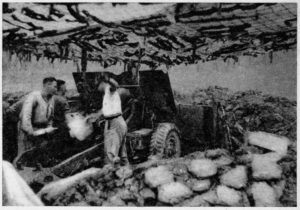 ______________________________
______________________________
Just as the date of the photographs is indicated in the article, so is the Brigade’s location: Near the Senio River, in northern Italy. This is described in greater clarity in Beckman’s book:
“On 23 March 1945 178 Company received new orders. They were to move up to the line at once, and again the long convoy, with their men eager for battle, took to the road. Eventually they reached their base at the small village of Brisighella. This was an idyllic spot, on a ridge from which they could look across orchards, olive groves and vineyards sloping down to the south bank of the Senio. Confronting their sector was the crack German 4th Paratroop Division. From their hilltop positions on the north side of the river, the Germans could observe the Brigade, especially during daylight hours, when their snipers and light artillery frequently reminded the more incautious Brigadiers that curiousity killed the cat.”
The series of maps and aerial photographs below – all from Google – show the Brigade’s approximate location at the time the above photographs were taken.
______________________________
______________________________
Northern Italy, showing major cities and highways. Though not visible at this scale, Brisighella is about half-way between Bologna and San Marino.
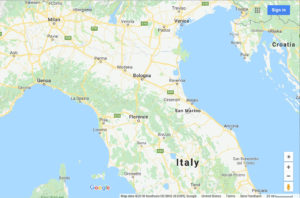 ______________________________
______________________________
Zooming in for a closer look. The Brigade’s approximate location is denoted by the red circle, to the southwest of Faenza.
 ______________________________
______________________________
Closer… This map brings surrounding cities, towns, and roads into greater clarity.
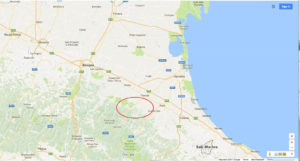 ______________________________
______________________________
And, closer… Brisighella, the location of the Brigade’s headquarters, is denoted by the blue oval, while the probable disposition of the Brigade itself is indicated by the red oval just to the northwest or Errano. Though not labeled on the map, the Senior River (Fiume Senio) winds between Riolo Terme and Ponte del Castello.
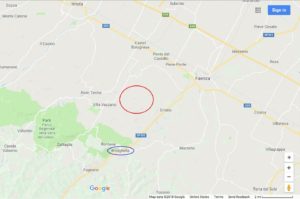 ______________________________
______________________________
More detail. The Brigade headquarters and probable location of the Brigade itself are indicated in blue and red, while the Senio River is the very faint, very thin, blue irregular “line” alongside Riolo Terme, Cuffiano, Tebano, and Biancanigo.
 ______________________________
______________________________
Here is an air (or satellite?) view of the map displayed above. Farms and cultivated areas are interspersed between hills.
 ______________________________
______________________________
The Senior River can be seen as an irregular blue line meandering just south of Riolo Terme, Cuffaino, and Biancanigo, and north of Tebano. German troops would have been situated north of the river.
 ______________________________
______________________________
And, an air / satellite view of the above.
 ______________________________
______________________________
Finally, a map of 8th Army dispositions in the Imola area (from the 85th Infantry “Custermen” Division) illustrates the location of the Brigade in the context of other Allied military units during the second week of April, 1945. The location of the Brigade is indicated by the red oval.
Websites
Brigadier Ernest Frank Benjamin (Wikipedia)
British Army Abbreviations (The Lincolnshire Regiment)
British Army Officer Rank Insignia (Wikipedia)
Capture of Imola (United States 85th Infantry Division)
Jewish Brigade (Wikipedia)
Jewish Brigade Group (Jewish Virtual Library)
Jewish Holiday (date and day of week) calculator (JewishGen)
NOAA – ESRL Sunrise / Sunset Calculator (NOAA)
Palestine Regiment (Wikipedia)
Books
Beckman, Morris, The Jewish Brigade: An Army With Two Masters, Spellmount, Stoud, Gloucestershire, England, 2014

